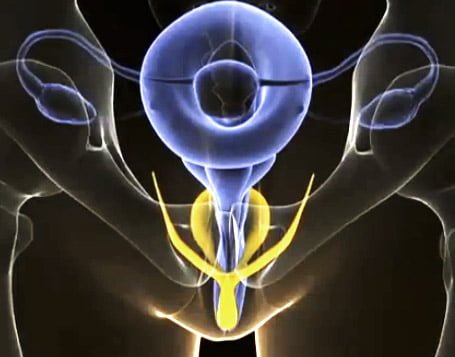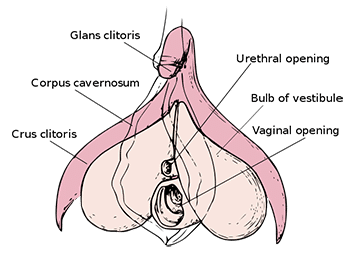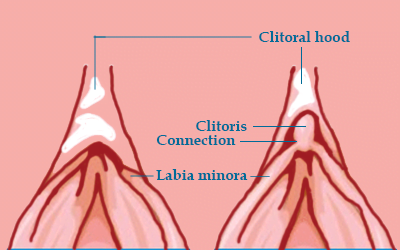The clitoris and female orgasm
The clitoris is connected to the labia minora (the inner labia) just above the urethral opening tucked into the vulva, with a large body of tissue actually inside the body, not just the glans, which is the bit you can see.
The clitoris is a sexual organ only and the most highly erogenous zone in women, capable of both sexual arousal and orgasm.
The size and sensitivity of the clitoris varies by woman, but all women have the deeper structures that wrap around the vagina.

Development of the clitoris
While the embryo is developing, the genital tubercle turns into either a penis or a clitoris – it is the same cells that would make the glans and upper shaft of the penis if the foetus was a boy.
This happens about eight weeks after conception has occurred. After the 14th menstrual week (the way doctors determine how many weeks old a foetus is), the gender can usually be seen, with an ultrasound determining gender after about 17 weeks. This is when clitoromegaly can be seen, after higher than average exposure to testosterone.
Historical observations of the clitoris
The clitoral glans (the sticking-out bit) was at first determined to be a useless and non-functioning organ, but upon closer inspection, it was found that the nerves of the clitoris actually cup the clitoris (corpus).
Watch this cool video of someone drawing the internal clitoris (Source: Museum of Sex)
The size and shape of the clitoris
The tip (glans) of the clitoris is the size and shape of a pea, but this is just the average – it differs widely between women, and there is no ‘normal’ (within ‘normal’ boundaries). They are all different, the same way penises are all different while remaining of same structure.
The clitoral hood covers the end of the clitoral glans. There is a shaft that extends up to the pubic mound, where the clitoris reverses direction and branches, as if two legs sitting atop a horse.

These are the clitorial crura, and they form the corpora cavernosa. The labia minora (inner labia) hide the clitoral crura, which end as they attach to the pubic arch, or continue to the posterior fourchette – the bottom of the vaginal entrance. Where the clitoral crura end depends on who you talk to.
The clitoral glans protrudes (sometimes a lot, sometimes a little) from the body, but there is no way to tell by the way someone looks – height, weight, age, contraception, fertility – what their clitoris will look like.
Blood and nerve supply to the clitoris
There is a large network of blood vessels and nerves, plus ligaments, the urethral sponge, vestibular bulb, perineal sponge, and muscles involved in the actions of the clitoris.
There are some striking similarities to the male version of the sexual organs, which allows us to accurately foresee the general behaviours, since the male sexual organs lie outside the body and can be examined more easily.
The corpus clitoridis has two separate chambers (corpora cavernosa), which is erectile tissue that swells with blood upon arousal, and a shaft that is attached to the glans clitoris. Each corpora is separated (but not entirely) from each other by a septum.

The clitoris has at last count over 8,000 sensory nerve endings, which is equivalent (or more) than the penis, and overwhelmingly beats any other part of the human body.
Sexual arousal and orgasm
When sexually aroused, the clitoris and other genital tissues swell with blood and change colour as a result of the blood influx. Each woman will experience slightly different sensations, however at orgasm, she will generally feel contractions. The female orgasm changes almost per occasion, with different areas of stimulation providing different types of orgasms.
How women orgasm
Research has found that most women (70-80 per cent) orgasm via direct clitoral stimulation, but any indirect stimulation may also work just as well. There is the somewhat mysterious vaginal orgasm, of which most women are found not to have, making the actual vagina not that important in terms of sexual satisfaction for women.
Without going into too much detail about the dispute regarding the existence of the g-spot, clitoral and vaginal orgasms, and so on, there are a million different ways to orgasm, and for our purposes, there is no real reason to get into a great discussion about it.
It must be noted that the female orgasm is still very mysterious in general to researchers, who, while busy doing studies, have taken a lot longer than the male equivalents, since the vagina has been put into a class of its own when it comes to being forbidden fruit, even for the medical community.
A lot of this information is only just beyond educated guesses – sad in our times, but true. The female orgasm has been largely defined by how the vagina affects men’s orgasm, not for its own unique physiology.
There appears to be a direct relationship between the ‘legs’ of the clitoris, the clitoral bulbs, the corpora, and the urethra and vagina. It seems the mythical g-spot is the other side of the clitoris – if you pull the skin off the inside wall of the vagina, you will find the clitoral bulbs, which in fact is a mass of erectile tissue.
The clitoral erection
When sexually aroused, the clitoris engorges with blood. This includes all the clitoral structures inside behind the scenes, and how this is precisely placed will differ with the woman it belongs to.
Some women will have more tissue than others, some will be more sensitive than others, some will need more or less stimulation to orgasm in their many different ways. This seems a reasonable reason why some women can orgasm by penetration, while others orgasm better from direct stimulation to the outer portion of the clitoris.
This also explains why scientific research hasn’t found any definitive proof that the g-spot even exists – it doesn’t exist, clearly, in all women.
This also means that trying to penetrate the vagina successfully (to orgasm) without engorging the clitoris is near to useless in terms of sexual arousal. It just doesn’t work.
The role of the cervix in sexual arousal
The cervix has been shown to be involved in sexual arousal, with very distinct sensations and brain regions lighting up during MRI scans mapping female sexual responses. Any woman who likes deep penetration will be aware of the cervix and its relationship to orgasm.





